| Botanical Name |
|
| Family |
Acanthaceae - The acanthus family. |
| Pronunciation |
hy-poh-ES-teez a-ris-TAH-tuh |
| Common Name(s) |
Afrikaans: Seeroogblommetjie
|
| Plant Group |
- Perennial A plant whose life cycle lasts for three or more seasons.
- Shrub A woody plant of relatively low height, having several stems arising from the base and lacking a single trunk; a bush.
|
| Plant Size |
- Small to Medium
| Tree | 8m to 15m |
| Shrub | 75cm to 1m |
| Perennial/ground cover | 20cm to 40cm |
| Bulb | 30cm to 40cm |
| Succulent | 20cm to 40cm |
|
| Position |
- Canopy Shade Canopy shade is found below closely grown trees where some light filters through. Ideal for the protection of herbaceous plants.
- Light or Dappled Shade Found below trees with sparse, open foliage. Ideal for the protection of herbaceous plants.
- Partial Shade The area is in shade for part of the day and in full sun for part of the day.
|
| General Information |
- Drought Tolerance: Moderate The plant is moderately adapted to arid conditions and can survive short periods of drought and high temperatures without extra water.
- Evergreen Plants that have leaves all year round.
- Frost: Half-hardy The plant is able to survive low temperatures and some frost but requires protection against severe frost.
- Prune hard after flowering Fast growing shrubs that grow lanky within a season. Cut off branches and stems of these plants to a third of their original length. This will increase the yield of flowers, improve the plants shape and enhance the structural strength of main branches.
- Water Wise Plant species originating from low rainfall regions that require less water to survive and thrive than other plant species.
|
| Specific Information |
Hypoestes aristata is an useful garden subject needing little care and can be utilized for out of the way plantings, which receive little or no water, as well as being a neat, rounded shrub for a backdrop in a low to medium height herbaceous border.
|
| Ad Break |
|
| Flowers |
| Description |
small flowers with showy bracts in loose spikes
|
| Season |
- Autumn to Spring Plants will seldom bloom for the entire season as given in the list, but should flower during a period within these parameters.
|
| Colour |
|
| Growth Rate |
- Fast Specifying growth rate can be very misleading as there is considerable variation of growth rate depending on type and species of plant, available water, supplementary feeding, mulching and general care, as well as the plants suitability and adaptability to the garden environment.
|
| Plant Uses |
- Attracts bees, butterflies or other insects This plant attracts insects which can be food for birds or other creatures in your garden.
- Border A strip of ground, at the edge of a driveway or path in which ornamental plants or shrubs are planted.
- Cut Flowers Plants that provide flowers suitable for ornamental uses.
- Filler Either a fast growing tree or shrub used temporarily to fill in an area while the permanent plants grow to a desired size, or a plant used to fill gaps in borders or beds.
- Mass Planting Plants useful for filling a large area with just one or a few kinds of plants spaced close together. Creates a bold, dramatic effect and to reduces maintenance.
- Pioneer for new gardens A very fast growing plant, able to withstand hardship, that can be used to populate land that has recently been cleared of natural vegetation. These plants pave the way for slower-growing species by adding nutrients to the soil and creating leaf litter.
- Stabilize Banks Plant is used to prevent soil erosion because their roots will form a mat that stabilizes the soil and keeps it from washing away in heavy rains.
- Suitable for coastal gardens Plants adapted to dry, sandy soil, forceful wind, limited rainfall and intense sunlight.
- Wild Garden An indigenous garden planted for the benefit of wildlife and birds. Provides food, water, a variety of mini-biomes and no poisonous chemicals are used.
|
| Distribution and Habitat |
Eastern Cape Province to KwaZulu-Natal, Limpopo and Mpumalanga, and north to tropical north Africa, in thick vegetation on forest floors and margins, in woodlands and in thicket bush clumps
|
| Planting Suggestions |
Plant in garden soil to which some compost has been added. Mulch well. Water regularly in summer but not in winter. Cut back hard after flowering.
|
| Medicinal Uses |
In some areas the leaves of the Ribbon bush is eaten as spinach The crushed leaves are used as a poultice for sore eyes.
|
| Ad Break |
|


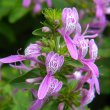
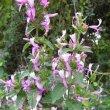
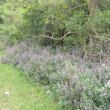
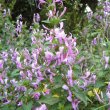
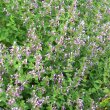


Comments
Hypoestes Aristata
Is this plant indigenous in South AFrica?
Hypoestes aristata
Yet it is. It is also indigenous to other tropical areas north of South Africa.
Discuss this plant
Share knowledge, ask a question or give an experience.